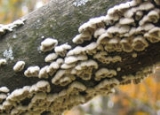
Schizophyllum commune
Encyclopedia
Schizophyllum commune is a very common species of mushroom in the genus Schizophyllum
. It is the world's most widely distributed mushroom
, occurring on every continent except Antarctica.
Although European and US guidebooks list it as inedible, this is apparently due to differing standards of taste rather than known toxicity, being regarded with little culinary interest due to its tough texture. S. commune is, in fact, edible and widely consumed in Mexico and elsewhere in the tropics . The authors explain the preference for tough, rubbery mushrooms in the tropics as a consequence of the fact that tender, fleshy mushrooms quickly rot in the hot humid conditions there, making their marketing problematic.
The gill
s, which produce basidiospore
s on their surface split when the mushroom dries out, earning this mushroom the common name Split Gill. It has more than 28,000 sexes.
It is common in rotting wood, but can also cause disease in humans.
Hydrophobin
was first isolated from Schizophyllum commune.
Schizophyllum
Schizophyllum is a genus of fungi in the family Schizophyllaceae. The widespread genus contains six wood-rotting species.-External links:*...
. It is the world's most widely distributed mushroom
Mushroom
A mushroom is the fleshy, spore-bearing fruiting body of a fungus, typically produced above ground on soil or on its food source. The standard for the name "mushroom" is the cultivated white button mushroom, Agaricus bisporus; hence the word "mushroom" is most often applied to those fungi that...
, occurring on every continent except Antarctica.
Although European and US guidebooks list it as inedible, this is apparently due to differing standards of taste rather than known toxicity, being regarded with little culinary interest due to its tough texture. S. commune is, in fact, edible and widely consumed in Mexico and elsewhere in the tropics . The authors explain the preference for tough, rubbery mushrooms in the tropics as a consequence of the fact that tender, fleshy mushrooms quickly rot in the hot humid conditions there, making their marketing problematic.
The gill
Gill
A gill is a respiratory organ found in many aquatic organisms that extracts dissolved oxygen from water, afterward excreting carbon dioxide. The gills of some species such as hermit crabs have adapted to allow respiration on land provided they are kept moist...
s, which produce basidiospore
Basidiospore
A basidiospore is a reproductive spore produced by Basidiomycete fungi. Basidiospores typically each contain one haploid nucleus that is the product of meiosis, and they are produced by specialized fungal cells called basidia. In grills under a cap of one common species in the phylum of...
s on their surface split when the mushroom dries out, earning this mushroom the common name Split Gill. It has more than 28,000 sexes.
It is common in rotting wood, but can also cause disease in humans.
Hydrophobin
Hydrophobin
Hydrophobins are a class of small, cysteine rich proteins that are expressed only by filamentous fungi. They are known for their capability of forming a hydrophobic coating on a surface of an object. They were first discovered and separated in Schizophyllum commune in 1991...
was first isolated from Schizophyllum commune.
Description
The cap is shell-shaped, with the tissue concentrated at the point of attachment, resembling a stem. It is often wavy and lobed, with a rigid margin when old. It is tough, felty and hairy, and slippery when moist. It is greyish white and up to 4 cm in diameter. The gills are pale reddish or grey, very narrow with a longitudinal split edge which becomes inrolled when wet; the only knows fungus with spit gills that are capable of retracting by movement. It is found predominantly from autumn to spring on dead wood, in coniferous and deciduous forest.External links
- "Schizophyllum commune", MykoWeb

